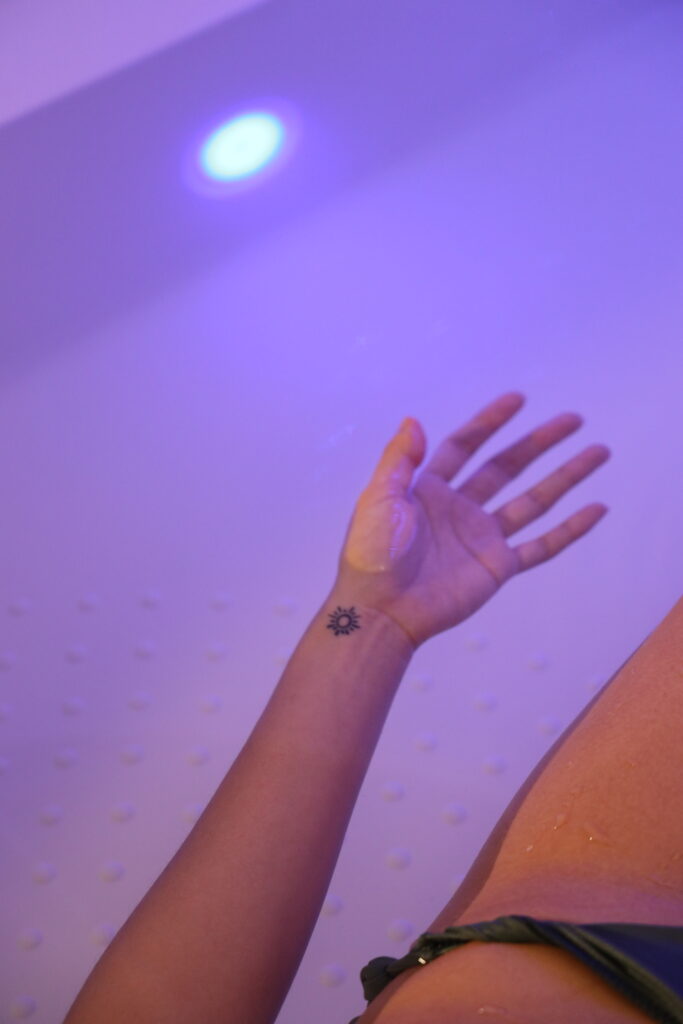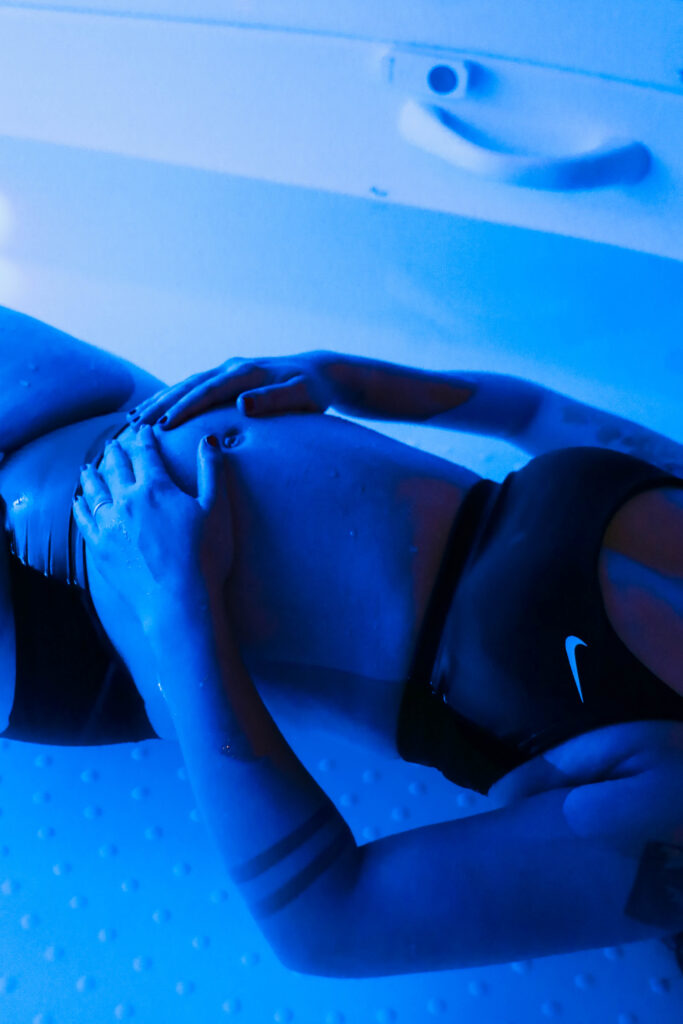What Float Therapy Did For Me At 36 Weeks Pregnant
My desire to escape from the physical discomfort of pregnancy led to unexpected moments of reflection on my motherhood journey.
by Laine Ng Read Original Article on Women’s Weekly
Having my first pregnancy at 36 (considered a geriatric pregnancy in medical terms), I was blessed on many fronts. A nausea-free first trimester, uneventful medical checkups, on-track foetal growth and development, and a robust fitness routine that encompassed everything from cardio and strength training to yoga. I’d managed to keep most pregnancy-related discomforts such as back pains at bay. Until I hit my third trimester.
As the weeks went by, my body reminded me of its changing state. A blocked nose, gastric reflux, and water retention (around the ankles and feet) made sleep an elusive luxury. Then the aches came, in the form of calf cramps and lower back pain triggered by my belly’s sudden growth. Massages helped to relieve those aches for a while, but I was looking for something else. Something more that would also ease the pressure on my pregnant body, and provide space for quiet reflection. Perhaps, float therapy?
Associated with sensory deprivation, float therapy involves floating in a tank filled with heated Epsom salt water that’s said to alleviate aches and reduce stress.

Despite initial apprehension from reasons such as claustrophobia, hygiene concerns and boredom in the tank, I decided to try out a 60-minute float therapy session at Soma Haus, a wellness centre in Joo Chiat. This was an apt time to see what floatation had to offer, before baby duties weighed me down.
Before booking the session, I consulted my gynaecologist and was given the go-ahead though he cautioned against going in any later into my third trimester, especially if there were already signs of labour. As with any special conditions, it is best to err on the safe side. Also, people with epilepsy, open wounds, or those currently undergoing chemotherapy or radiation therapy should not be using this alternative form of therapy.
My first experience with float therapy
Though not a requirement, guests are encouraged to shower before entering the tank for float therapy. Soma Haus’ shower facilities made it easy for me to do so. The pleasing scents of the soap and shampoo from homegrown brand The Verdant Lab helped calm my nerves.
Entering the tank, I had some expectations. I imagined that the Epsom salt water would work its magic instantaneously and melt away my water retention, and that I might feel anxious or restless in the confined space. Reality turned out to be a surprise.
There were moments of restlessness initially, but the soothing background music helped me settle into the water quickly. Guests have a choice of entering the tank naked or in swimwear; I opted for the former.
Surprisingly, it didn’t take much courage to be enveloped naked in semi-darkness. I spent about five minutes thinking about what I should think about… before realising that the music was gone and I had fallen asleep for a bit.
I was roused by the sensation of salt on my face. As I sat up to wipe my face with a nearby towel, I experimented with different light settings in the tank. That prompted me to reflect on my pregnancy journey from the start to present, and allowed me to get in touch with how I was feeling at that point in time.
Eventually I switched off the lights, and fell asleep again. Before I knew it, an hour had passed.
What float therapy did for me at 36 weeks pregnant
1. I could sleep on my back (at least for a while)
What struck me the most during this experience was the relief it brought to my pregnant body — specifically the left side I was recommended to sleep on during pregnancy, to preserve blood flow to the growing foetus. I had missed sleeping on my back, which became uncomfortable ever since my belly got really big in my third trimester. The sensation of floating in the tank was akin to resting on a waterbed seamlessly shaped to your body’s needs. In the tank, sleeping on my back was possible again. It felt like a dream.
2. It cooled me down and cleared my nasal congestion
With my pregnant body feeling like an oven thanks to greater blood flow and my little one emitting body heat from within, I found respite in the tank. The water temperature felt comfortably cooling after a while.
Another unexpected benefit was the relief from my pregnancy rhinitis, a common condition that causes nasal congestion due to increased blood flow and nasal vein enlargement. I had to rely on air conditioning at home, which exacerbated my stuffy nose. In the tank, I could breathe freely while keeping cool, making me a much happier mama. If only I could access the float tank anytime!
3. It gave me the opportunity to meditate
As it turned out, my time in the tank was less about sensory deprivation and more about sensory enhancement.
As a first-time expectant mum, my mind was often buzzing with worries and scattered thoughts – from coping with weekly bodily changes, to the fear of the unknown (think horror labour stories), financial stress, and more. I was definitely not in the best mental state during my pregnancy.
However, once I entered the tank, I found a tranquil haven away from the outside world.

In that peaceful cocoon of warm water, I discovered a profound sense of quietude that allowed me to reflect on my pregnancy journey. It was a meditative experience, a chance to gather my thoughts and find focus amid the chaos of anticipation and excitement.
As I floated effortlessly, I wondered if this was how my baby felt in the womb, safe and weightless. It was also then that I wondered if this was why water birthing is such a popular choice amongst some mothers — the skin-temperature water provides relaxation and buoyancy, reducing pain and stress during labour.
Overall thoughts
The benefits of float therapy for pregnant women are evident: stress relief, moments of peace before the impending chaos of childbirth and postnatal life, and a release of tension on heavily burdened lower limbs. It offers not only physical relief, but also a conducive space for reflection on the unknown journey of motherhood that lies ahead.
Now that I’ve experienced float therapy’s mental health benefits, I would love to go for monthly sessions – if my postnatal schedule allows. In terms of targeting aches and pains, I would still prefer massages as they provide instant relief.
Good to know for first-timers
For those new to float therapy or with claustrophobia concerns, Soma Haus offers various floatation aids and levels of progressions. I chose to begin with some soft lighting inside the tank, and leaving the tank partially open.
While I had floatation aids at my disposal, I didn’t need them. The density of salt water is much higher than our body density – that helps the body float effortlessly. As the water level in the tank is relatively low, it’s easy to transition from floating to sitting position. Clumsier-than-usual pregnant bodies will appreciate the handles at the sides of the tank, plus an assistance button that’s within easy reach.
Since you’d be immersed in salt water for an hour, be prepared for salt to get onto your face or eyes. You can easily wipe it off with a towel on standby.
Post-float, remember to drink lots of water as salt water is dehydrating.
To book your first session with us, click here.